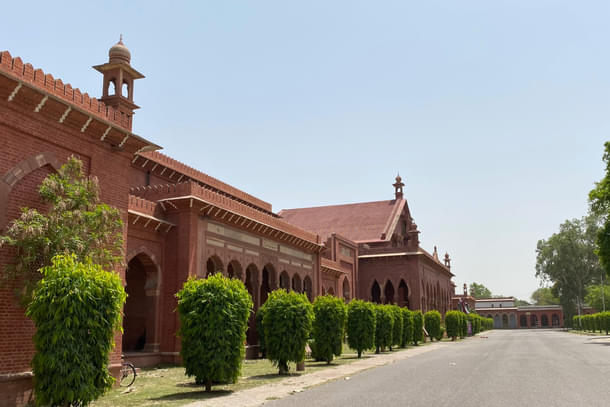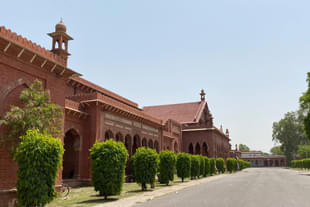Ideas
AMU, Article 30, And The Supreme Court Judgement: Protecting Identities Or Freezing Them In Time?
Adithya Reddy
Dec 23, 2024, 12:13 PM | Updated 12:20 PM IST
Save & read from anywhere!
Bookmark stories for easy access on any device or the Swarajya app.


The recent Supreme Court judgement on the minority status of Aligarh Muslim University may have turned majorly on the technicalities involved in the legal interpretation of terms in the Constitution. This did not eliminate the role of background policy justifications for and against having a separate provision for minorities in the Constitution.
The majority view of the Chief Justice noted “the imperative to enable minorities to maintain their distinctive characteristics and fulfil their specific needs,” and at least one of the dissenting judges appealed to ‘national integrity’ while rejecting the claim of minority status.
These views, more or less, mirror the opposing views in the Constituent Assembly on the issue and the different stands the Supreme Court itself has taken in various cases over the decades.
The perception is that the Constitution’s basic task is to balance these two opposing views, namely, the need to protect minority rights from a dominant majority through some kind of positive discrimination and the need for a secular state to maintain its unity and integrity.
The persisting problem of communalism and increased political cleavages in society should make us look beyond a common strand that runs through both these opposing views, that they are both influenced by a kind of secularisation that has taken over the world, starting from its source in the West’s Enlightenment.
Many scholars have written about alternatives. It is worth highlighting the views of two of them — one Canadian and one Indian.
To be Transformed by ‘the Other’
Charles Taylor is a remarkable philosopher who has churned out one magisterial work after another, critiquing the dominant currents in political philosophy.
Citing the example of cyclical racial tensions in America, in his latest book published at the age of 92, Taylor claims that with Gandhi comes “a great step forward” in finding an alternative basis for ethical progress in politics. The basis for this view is his well-known work from earlier decades on the theory of ‘recognition’.
In this work, he shows how difficult it is to reconcile “the two modes of politics” at play in a multicultural society where one section feels threatened by the other — “the principle of equal respect requires that we treat people in a difference-blind fashion… for the other, we have to recognize and even foster particularity.”
This difficulty becomes almost insurmountable when the balancing between the two has to be done from a purely neutral standpoint or without having to make any judgement on the worth of the cultures involved.
The demand of the cultural minority, according to Taylor, is not for a condescending appreciation of worth without truly believing such judgements are possible or recognition from an ethnocentric or unfamiliar point of view.
To cite Taylor’s example, “To approach a raga with the presumption of value implicit in the well-tempered clavier would be forever to miss the point.” He adds: “real judgments of worth suppose a ‘fused horizon’ of standards… that we have been transformed by the study of the other.”
It is this kind of recognition that adherents of any culture seek from their fellow citizens, to genuinely feel secure and content.
‘Narrow Secularism’ Versus ‘Religious Pluralism’
The works of Sociologist T N Madan present a similar break from the consensus that prevailed in post-independent India about the ideas of secularism and state-led social reform.
Madan traces the origins of today’s majority-minority divide to the political representation that followed the introduction of local-self government by Lord Ripon in 1882. Soon thereafter, Sayyid Ahmad Khan presented his two-nation thesis.
Madan says ‘imagined’ majorities and minorities were pitted against each other by politicians “without any regard for the social reality of the multiplicity of… interests and… opinion.”
The inclusion of minority rights in Article 29 and 30 of the Constitution and the manner in which they have been understood subsequently cannot be divorced from this background.
The idea that in the absence of a neutral state there will either be ‘mutual exclusion’ or ‘unilateral surrender’ has ruled out the possibility of any ‘synthesis’.
According to Madan, ‘Indic religions’, with their openness to questioning from within and flexibility of attitudes, provide resources for sociocultural reconciliation.
He says India’s cultural traditions “share crucial metaphysical presuppositions… contribute to the overall cultural ambiance of the country, and provide the foundation for regional composite cultures.”
Even Islam and Christianity as they evolved in India cannot be said to be alien to these traditions. These resources, according to Madan, can be strengthened only in the absence of ‘narrow secularism’.
The Path From Aligarh
Aligarh ranks, along with much bigger cities, among the top five most riot-prone places in India.
In her work on the city, Juliette Galonnier quotes a Muslim AMU professor: “I come from a cosmopolitan city (in Bihar)… we lived together in Hindi culture… there was no discrimination (between Hindu and Muslim). But here I see a dislike of Hindi language in schools… they made me conscious that ‘this is Hindu culture, and this is Muslim culture’.”
Galonnier shows how AMU and issues related to it have not only divided Hindus and Muslims but have also left local Muslims deeply dissatisfied with its non-local character.
The suggestion is not that rights under Article 30 have led to the kind of situation that prevails in Aligarh today. To make this connection would be beyond this writer’s expertise. But it is important to know that the original proponents of minority rights in India, like Sayyid Ahmad and Iqbal, were influenced by Western ideas not far removed from those that drive modern political discourse in general.
To move towards the ‘fusion of horizons’ that Taylor talks about (borrowing from another great German philosopher) or to even explore the possibility of ‘synthesis’ that Madan believes should not be ruled out, the state and citizens must move beyond ‘peremptory and inauthentic judgments of equal value’.
The answer cannot be preferential treatment like what is contained in Article 30, while at the same time maintaining an aspiration to bring everyone back to a ‘difference-blind’ state of equality. This will only lead to freezing of identities in their purely instrumental sense for indefinite future generations.
Like Taylor says, “after all, if we’re concerned with identity, then what is more legitimate than one’s aspiration that it never be lost?”
The resources for alternative means of healing social differences have to come from indigenous traditions that have allowed for people to transform their own standards while interacting with other cultures.
Adithya Reddy is a Chennai-based lawyer.





